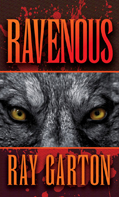Notes on Ravenous
 For too long, the werewolf has been the Rodney Dangerfield of the horror genre. He's never gotten any respect. He's never gotten the respect he deserves, at least, not in my opinion. And this is despite the fact that he's been the star of some great horror movies.
For too long, the werewolf has been the Rodney Dangerfield of the horror genre. He's never gotten any respect. He's never gotten the respect he deserves, at least, not in my opinion. And this is despite the fact that he's been the star of some great horror movies.
In 1935, Henry Hull played The Werewolf of London and six years later, Lon Chaney, Jr. turned into The Wolf Man, probably the most iconic werewolf. The latter was Universal's biggest moneymaker in 1941, but after that, Larry Talbot's wolf man was relegated to making appearances in movies that focused on other monsters, like Frankenstein Meets the Wolfman, House of Frankenstein and House of Dracula and Abbott and Costello Meet Frankenstein.
Two years before he moved to the Ponderosa and became Bonanza's Little Joe, Michael Landon's hormones got the best of him in I Was A Teenage Werewolf, an enjoyable but low-rent drive-in werewolf movie from American International Pictures. For decades, Hammer Studios turned out dozens of horror films, including eight Frankenstein titles, seven Dracula movies ... but only one werewolf movie in 1961, The Curse of the Werewolf.
Aside from hackneyed, low-budget schlock, it was twenty years before another loving, quality effort was made to bring the werewolf to the screen. The Howling and An American Werewolf in London were both released in 1981, which remains the best year for werewolf movie fans in all of human history. 1994 saw the release of Mike Nichols's top-drawer production Wolf and in 2010, The Wolfman was lovingly remade with effects by the great Rick Baker. Both got a tepid reception and failed to revive interest in monster movies.
While the werewolf hasn't been ignored, compare his record to all the movies that have been made about ghosts, or vampires, or the lumbering, brain-hungry zombie, or even the one-note mummy.
The werewolf pops up in literature from time to time. Two from the 1980s come immediately to mind — Stephen King's Cycle of the Werewolf and Robert McCammon's memorable werewolf-Nazi mashup The Wolf's Hour. There have been some wonderful werewolf novels from W.D. Gagliani, William D. Carl, Jonathan Maberry and others, of course, but they have been sporadic. These days, werewolves seem to be most commonly found in urban fantasy or paranormal romance. The werewolf as monster — I mean, the scary kind — are much harder to find.
Over the decades, the vampire has had all the horror cachet. The vampire is horrifying because he's a walking corpse and wants to suck your blood and turn you into a walking corpse. He's sexy because he gets to keep his good looks and he can't be killed, so he's been around for a long time, has seen everything and has lots of experience. The vampire is erotic because what he (or she) does is deeply intimate and involves penetration and sucking. His allure is that he can relieve you of your mortality and allow you to "live" on and on as a supernatural being superior to all those around you. The vampire changes with the times. He began as the mustachioed, grey-haired man with hairy palms in Bram Stoker's Victorian novel and has morphed over the centuries into sparkling, angst-ridden teenagers.
But the werewolf remains unappreciated, underused and taken for granted. When the editor at Leisure Books became convinced that werewolves were going to be the Next Big Thing and asked me to write a werewolf novel, I jumped at the chance.
It had been so much fun writing Live Girls back in the 1980s. Vampires had always been sexy — Stoker's Dracula had kicked Victorian prudishness in the nuts — but the sex was never explicit. I set out to change that. I wanted to do the same thing with werewolves. Sex was not associated with werewolves at all, not even implicitly, and I couldn't understand why. After all, the transformation from human into werewolf removes all inhibition and self-consciousness. The werewolf gives no thought to social conventions, taboos, the law, or whether or not either party uses protection. The werewolf is the id unleashed, a human's animal nature stripped naked. And what do animals do? They eat and fuck. They fuck and eat. It occurred to me that a werewolf might do both at the same time.
Of course, werewolves aren't as suave as vampires. They don't charm and seduce. They're animals. They take what they want. Sexually, that would be a kind of rape. I say a kind of rape because rape as we know it is not a sexual act, it's a brutal act in which sex is used to dominate, demean and demoralize the victim. In the violent act of rape, sex is the weapon used, not the desired goal. A werewolf, being an animal following animalistic urges, would simply be fulfilling a need without any agenda, but also without any concern for the person involved. I want sex, you're here, so I'm taking it from you — except it would not be an articulate thought, more like an urge. Sex would be the goal, but against the will of a human target, of course, it would be rape. Rape is not sexy. But it's a horrifying threat and appropriately monstrous behavior for a monster, which is what a werewolf is. The connection between the werewolf and sex would have to be found elsewhere.
In 1941's The Wolf Man, writer Curt Siodmak concocted the werewolf mythology we know today. He invented it from whole cloth. Maria Ouspenskaya, playing the old gypsy woman Maleva, delivers the memorable line, "Even a man who is pure at heart and says his prayers by night, may become a wolf when the wolfbane blooms and the autumn moon is bright." This has long been thought to be an authentic Gypsy or Eastern European folk saying, and some sources even list it as such. But Siodmak made it up.
Siodmak came from Germany, where his life was disrupted by the rise to power of Hitler and the Nazis. Suddenly, Siodmak — like so many others — was a hunted criminal simply because he was a Jew, just as Larry Talbot was suddenly a monster, marked by the pentagram. Siodmak invented the entire werewolf mythos — the connection to the moon, the pentagram, the idea that a werewolf could be killed with silver, all of it. He made lycanthropy a supernatural curse that was passed on through the werewolf's bite. Anyone bitten by a werewolf would become a werewolf during the next full moon.
But what if instead of a supernatural curse, lycanthropy were a condition passed on through bodily fluids? What if it were, say, a virus? Better yet, what if it were a sexually transmitted disease that could be passed on by having sex with someone you didn't know was a werewolf — a werewolf in its human form? And with that, I had my modern-day werewolf.
Ravenous is set in the quiet coastal northern California town of Big Rock. But it doesn't stay quiet for long. When I finished Ravenous, I knew I had more of it in me and went to work almost immediately on the sequel, Bestial. And I plan to return to these werewolves in the near future.

